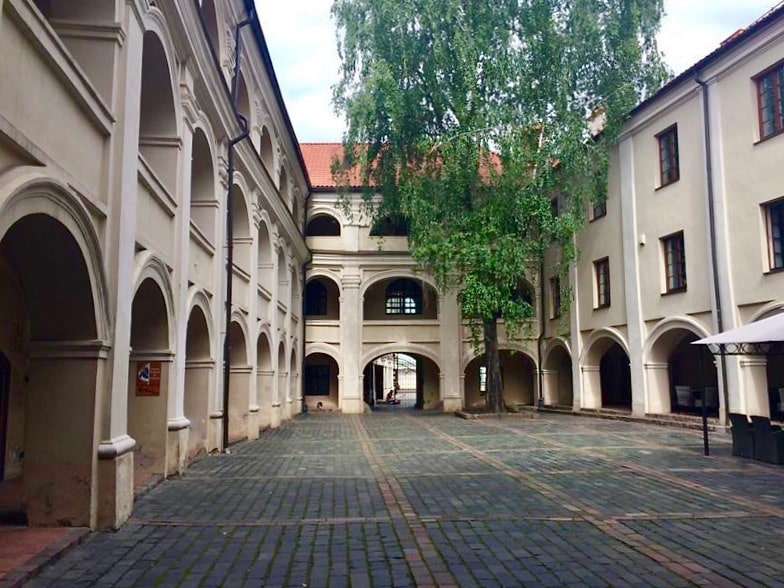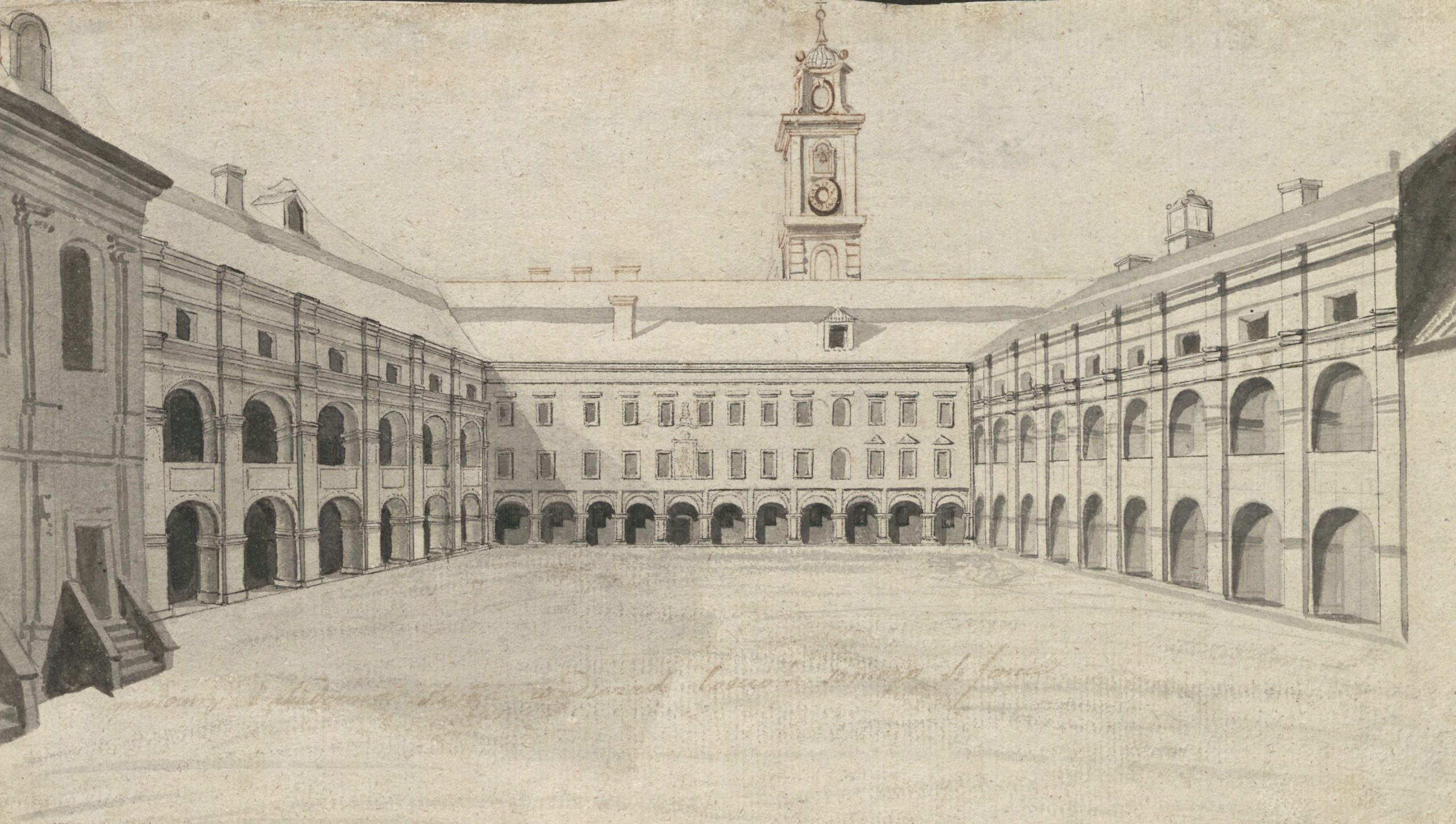The reputation of the Basilian Monastery of the Holy Trinity in Vilnius as a center of higher education was formed in the times of the Commonwealth. Above all, it was grounded on the participation of the monks in teaching and studying at the so-called Collegium Pontifici – a pontifical seminary or aluminate [1]. In 1794, out of 46 inhabitants, 18 were students of philosophy and theology at this educational institution.1ÖNB Wien, SN 3849; LVIA, f. 515, ap. 15, b. 64, l. 60. At the end of the 18th century, the rector, a professor of theology at the seminary, was perhaps the most famous Vilnius Basilian of that time, Paschazy Leszczyński, and three of his fellow monks were also professors – Ambrozy Kiryat (theology), Naucratius Zaniewicz (theology), and Martynian Stefanowicz (philosophy).2LVIA, f. 515, ap. 15, b. 5, l. 60. From the start of the 18th century, a number of Basilians also studied at the Vilnius University [2, 3].3Ina Kažuro, “Bazilijonų vienuolijos ryšiai su Vilniaus universitetu”, Lietuvos istorijos studijos, 2018, t. 42, p. 29–47.
In the first decades of Russian rule, the monastery continued the difficult work of preparing educated personnel. Despite the closing of the pontifical seminary in 1798, projects introduced by Russian officials to build up the system of school education, which in various configurations arose from the need for an involvement of the monastery’s resources as widely as possible, created generally favorable conditions for the Basilians’ educational activities. Already in 1796 Governor General Nikolai Repnin had created the Lithuanian Educational Commission, which limited the secular character of the Vilnius University under the influence of episcopal chapters. A number of secular schools were then placed under the direction of ecclesiastical institutions.4Daniel Beauvois, Wilno – polska stolica kulturalna zaboru rosyjskiego 1803–1832, Wrocław: Uniwersytet Wrocławski, 2012, s. 28.
After the Vilnius University was raised to the rank of an imperial university in 1803 and its educational district created, the process began of enlisting monks in the government system of education. The work of the Basilian seminary was renewed, and it received the status of a major department of Vilnius University [4].
On the basis of the decree of Emperor Alexander I of 27 July 1807 (finalized with the mediation of the minister of national education, Piotr Zawadzki, the Basilians had to take on the function of a teaching corporation. The government recognized “the Basilian spiritual congregation” and guaranteed its “existence only where schools exist, where homes for the aged will be, or schools for a novitiate […] with its goal of introductory education for administrative authorities. The Vilnius monastery has been designated as the single place for the scholarly formation of the Basilians.”5Marian Radwan, “Bazylianie w zaborze rosyjskim w latach 1795–1839”, Nasza Przeszłość, 2000, t. 93, s. 189.
Afterwards, no Uniate monk could conduct educational activity if he had not graduated from the seminary at Vilnius University or in Pochaiv and had not acquired the appropriate qualification document from school authorities. It was now required to spend a minimum of 15 years at school, which would give the right to hold ecclesiastical positions. It was recommended that teaching monks acquire doctoral degrees, especially candidates for leading positions in the Order of St. Basil the Great. The religious authorities assigned the teachers to institutions in conjunction with government school structures. Church authorities administered the monastery’s educational funds, but under the supervision of the government administration.6Ibid., s. 190.
In 1805, Paschazy Leszczyński wrote that the monastery “educationally supports [Basilian] youth at Vilnius University”.7LVIA, f. 634, ap. 3, b. 253, l. 12. Most often, the most educated and capable candidates, who already had previous educational experience – first at secular introductory training schools and eventually, after joining the Basilian Order, in internal religious schools at various monasteries, where monks acquired secondary education analogous to today’s – ended up at Holy Trinity Monastery. The monastery had a large group of monks from the territory of today’s Ukraine, who mastered the basics of languages (Church Slavonic, Polish, and Latin), oratory, mathematics, geography, theology, canon law, and history at Pochaiv Monastery and the Basilian school in Kremenets.
Of the 26 inhabitants of the monastery from 1835 to 1841, there were 16 who had the experience of studying at Vilnius University.8LVIA, f. 1178, ap. 1, b. 91, l. 35–116. Individual monks managed to acquire the degree of a doctor at Vilnius University or of a candidate in theology/philosophy. Having the official status of students of the Imperial University of Vilnius, the Basilians, in additional to moral and dogmatic theology, also mastered literature (classical and contemporary French, German, Russian, and Polish), and a majority of them studied the natural sciences.
Receiving the degree of a master of philosophy or theology, and also passing the test for a teaching certificate, opened for the Basilians the road to teaching, both in internal spiritual schools at various monasteries and also in the public educational system. According to the competencies acquired, young teachers taught in county schools (sometimes in lyceums) languages, secular subjects, the divine law, and morality. After acquiring a pedagogical education (which, in separate instances was fairly lengthy and varied), some of the monastics returned to the Vilnius monastery permanently.9Ibid., l. 38, 48–50.
Before becoming professors at the pontifical aluminate or the main seminary, the Basilians needed to undergo the practicum of internal teaching for young monks who either were preparing to enter higher educational institutions or had already studied at one but the level of their knowledge was not adequate. So a famous future professor at Vilnius University, Cezary Kamiński, started as a teacher of philosophy at an internal school.10LVIA, f. 515, ap. 15, b. 5, l. 60v. Monastery teachers received an average monetary income that was small, 7 rubles, 50 kopecks silver annually.11LVIA, f. 1178, ap. 1, b. 91, l. 36, 48–50. This internal-monastic school did not have a public character, that is, it did not allow secular students within its walls. There was, however, at the monastery a boarding school for nobles, whose boarders received total support12ЦДІАЛ України, ф. 201, оп. 4б, спр. 127, арк. 7. and acquired a primary education, in parallel attending the Vilnius gymnasium. In 1805, this boarding school housed 16 boys. The Basilian women’s monastery had a similar school for internal preparation; in 1805 there were eight girls there (↑).13РГИА, ф. 567, оп. 2, д. 107, л. 11зв., 30зв. In the protocols of the 1805 visitation by the inspector of the Vilnius educational district to the Basilian dormitory, in which, with the profits from the Sawanewski building, four pupils (boarders) from “poor nobility”, were “fed” and “clothed”, it is stated: “In the examination in introductory studies, which are taught at the boarding school, the borders in an appropriate way responded to questions given to them, demonstrating their knowledge in the Polish, Latin, and Russian languages. The visitator then visited their living quarters and found them presentable and neatly kept.”14Ibid., л. 19зв.
In addition to the four so-called “Sawanewski boarders”, the Basilians provided for 10 (as of 1819) to 12 (as of 1805) poor pupils, so-called “paupers”, some of whom attended the gymnasium together with children of the nobility.15Ibid, л. 20.
A devastating blow to the important position of the Basilians in the educational system was the closing of Vilnius University, according to the decree of Emperor Nicholas I (1796–1855) of 1 May 1832. As a consequence, the monks lost the opportunity to acquire a higher education and teach in government schools. This act ended the most successful period of educational activity in the history of Holy Trinity Monastery, which was directed not only at satisfying the order’s needs for internal formation but at the good of society. As a result of the liquidation of the Vilnius educational district, the Basilians not only lost their status as a teaching congregation but lost their, in fact, immunity from being closed, which had negative consequences for the existence of the monastery, which entered into a period of decline and gradual liquidation (↑).
Vadym Adadurov
Išnašos:
| 1. | ↑ | ÖNB Wien, SN 3849; LVIA, f. 515, ap. 15, b. 64, l. 60. |
|---|---|---|
| 2. | ↑ | LVIA, f. 515, ap. 15, b. 5, l. 60. |
| 3. | ↑ | Ina Kažuro, “Bazilijonų vienuolijos ryšiai su Vilniaus universitetu”, Lietuvos istorijos studijos, 2018, t. 42, p. 29–47. |
| 4. | ↑ | Daniel Beauvois, Wilno – polska stolica kulturalna zaboru rosyjskiego 1803–1832, Wrocław: Uniwersytet Wrocławski, 2012, s. 28. |
| 5. | ↑ | Marian Radwan, “Bazylianie w zaborze rosyjskim w latach 1795–1839”, Nasza Przeszłość, 2000, t. 93, s. 189. |
| 6. | ↑ | Ibid., s. 190. |
| 7. | ↑ | LVIA, f. 634, ap. 3, b. 253, l. 12. |
| 8. | ↑ | LVIA, f. 1178, ap. 1, b. 91, l. 35–116. |
| 9. | ↑ | Ibid., l. 38, 48–50. |
| 10. | ↑ | LVIA, f. 515, ap. 15, b. 5, l. 60v. |
| 11. | ↑ | LVIA, f. 1178, ap. 1, b. 91, l. 36, 48–50. |
| 12. | ↑ | ЦДІАЛ України, ф. 201, оп. 4б, спр. 127, арк. 7. |
| 13. | ↑ | РГИА, ф. 567, оп. 2, д. 107, л. 11зв., 30зв. |
| 14. | ↑ | Ibid., л. 19зв. |
| 15. | ↑ | Ibid, л. 20. |
Sources of illustrations:
| 1. | Held in: KPC PB. Published in: „Alumnatas“ [unique code: 772], in: Kultūros vertybių registras, available at: https://kvr.kpd.lt/#/static-heritage-detail/1346F4E9-74CF-4C6C-B01F-F30A24408B6A, photograph no. 1, accessed: 2021 12 01. |
| 2. | Universitas et Academia Vilnensis…, Vilnae: Typis Sacrae Regiae Majestatis penes Academiam, 1781, [p. 3]. Held in: VUB, Retų spaudinių skyrius, IV 30991; BJ, BJ St. Dr. 103814 I (Available at: Jagiellońska Biblioteka Cyfrowa. Uniwersytet Jagielloński, https://jbc.bj.uj.edu.pl/dlibra/publication/320802/edition/307008/content, accessed: 2021 12 01; BN, SD XVIII.3.4284 (Available at: Polona, https://polona.pl/item/universitas-et-academia-vilnensis-olim-a-valeriano-protasewicz-vilnensium-antistite,MTM0MTAwNjI3/0/#info:metadata, accessed: 2021 12 01). Another version: Prospectus lectionum in Alma Universitate et Academia Vilnensi…, Vilnae: Typis Sacrae Regiae Majestatis penes Academiam, 1781–1782. Held in: VUB, Retų spaudinių skyrius, IV 16172/1781-82; LMAVB, Retų spaudinių skyrius, L-18/2-42 (Available at: Lietuvos mokslų akademijos Vrublevskių biblioteka. Skaitmeninis archyvas, https://elibrary.mab.lt/handle/1/25431, accessed: 2021 12 01). |
| 3. | Held in: VUB, Rankraščių skyrius, F78-167. Published in: Nijolė Bulotaitė, „Smuglevičius: Romoje išgarsėjęs, Vilniuje įsiamžinęs“, in: Vilniaus universiteto biblioteka, 2020, available at: https://biblioteka.vu.lt/apie/naujienos/1186-smuglevicius-romoje-isgarsejes-vilniuje-isiamzines, accessed: 2021 12 01; „Vilniaus paveikslų galerijos ekspozicija“, in: Lietuvos dailės muziejus, available at: http://old.ldm.lt/Ekspozicijos/SmuglP_VU_kiemas.htm, accessed: 2021 12 01). |
| 4. | Published in: Album de Wilna, series 2, book 3, ed. Jean Kasimir Wilczyński, 1850, ill. 33. Held in: LNM, LNM IMik 9133/8. Later publications: Vilniaus universitetas dailėje, eds. Dalia Ramonienė, Nijolė Tumėnienė, Vilnius: Vaga, 1986, ill. 282; Vilnius Jono Kazimiero Vilčinskio leidiniuose = Vilnius in the Publications of Jan Kazimierz Wilczyński, eds. Aldona Bieliūnienė, Birutė Kulnytė, Simona Likšienė, Rūta Subatniekienė, Vilnius: Lietuvos nacionalinis muziejus, 2000, p. 71; Jonas Kazimieras Vilčinskis. Vilniaus albumas = Jan Kazimierz Wilczyński. The Vilnius Album, ed. Diana Streikuvienė, Vilnius: Lietuvos nacionalinis muziejus, 2021, p. 57–58. |






